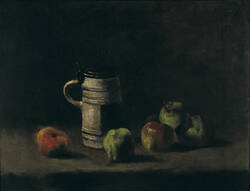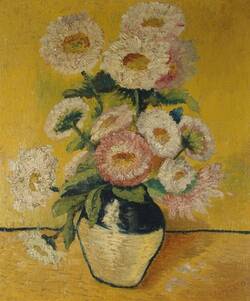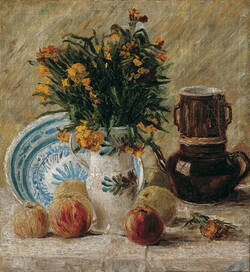Three paintings previously attributed to Vincent van Gogh are now in the Von der Heydt Museum's collection as works by unknown artists. How can this be?
The Still Life, with a vase of flowers on a table surrounded by fruit and ceramics, was donated to the museum by Eduard von der Heydt in 1952. He had received it from his father, who had been in possession of it since at least 1918. It is listed in the catalogue 'Die Sammlung des Freiherrn August von der Heydt' by Carl Georg Heise, which can be found on the bookshelf in this exhibition. The painting is not signed, which is not unusual. The attribution was not questioned for many decades and the painting was considered one of the highlights of the collection. It was only after a detailed restoration and examination of the materials by experts from the Van Gogh Museum in Amsterdam that doubts about the painting's authenticity were confirmed. For example, pigments were found which, according to current knowledge, were not used by the artist. The brushstroke was also recognised as unusual for van Gogh. As a result, it was attributed to the artist and has since been listed under Artist/Creation 'Unknown'.
The situation is similar with Still Life with Jug and Pears, which entered the museum's collection in 1964 as a bequest from Eduard von der Heydt. This painting, too, has been listed for decades as an early work by van Gogh and is included in the various catalogues raisonnés, which carries great weight as an indication of authenticity. But here too, doubts about the attribution have been confirmed, as pigments unknown to the artist have been identified, and the painting is no longer considered to be by the famous Dutch painter. It is clear that, in addition to the written tradition, stylistic comparisons and, in particular, technical material studies are of great importance in confirming or correcting presumed knowledge. This is why participation in international research projects and networking within the scientific community are so important when working with the objects.
Bouquet of Asters, hanging in the middle of the row, came into the collection in 1952. This painting also came from the collection of August von der Heydt and had been in his possession since at least 1918. In the first edition of the catalogue raisonné in 1928, it was still listed as a work by van Gogh. However, in the subsequent editions of 1939 and 1970, it is no longer recognised as an authentic work by the artist. At the bottom right, the artist's signature is recognisable as a poor imitation. In this case, therefore, we can speak of a forgery rather than a misattribution.
In the collection presentation "Times and Spaces. Classics of the Collection", there are two paintings by Vincent van Gogh whose authenticity is beyond doubt.




